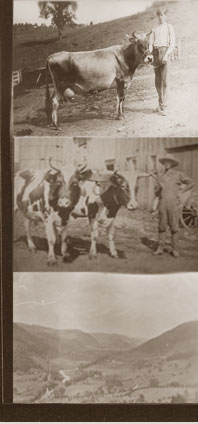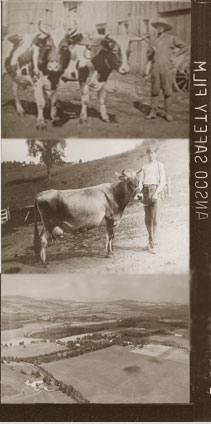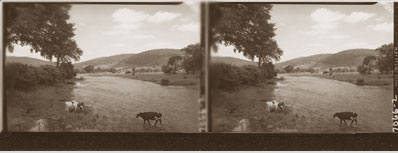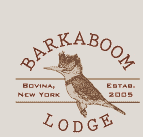


The Catskill Turnpike, that late 18th Century expressway from the Hudson to the West, was a commercial venture. It ran through land owned by the stockholders who collected a toll from all who passed by.
It was six rods wide and traversed 86 miles from Catskills to Unadilla, a milestone marking each mile of the way.
The milestones were the basis on which fares were figured and tolls paid. The toll gates were about ten miles apart and you reckoned five cents a mile from the first milestone you passed.
The Catskill Turnpike had a prosperous, useful and peaceful career for many years, but little troubled by the Indians. The Erie Canal and the coming of the railroads marked its passing, but the modern motorist can stiill follow most its route today and, if persistent, can even find the few remaining milestones.
It is surely the most enduring beautiful country in the world, this serene County of pasture, woods and water. On the Catskills' Western slopes, Delaware County is a land of mountains and valleys, of sudden spectacular vistas and gentle, sheltered aspect.
The abundance of water is one of its great charms-- a bend in the road and there before you is a still pool: another bend and the road carries you over one of hundreds of streams, a wild, stony torrent, a stately, well-bred river, or maybe only a merry little creek.
Another Delaware splendor is its trees- hundreds of varieties of beautiful old trees lining highway and main street, lovely in spring and summer and a great glory in the fall.
The hunting and fishing are superb.
Delaware County covers 1460 square miles, an area larger than that of Rhode Island. It ranges from valley bottoms of 100 feet above sea level to peaks higher than 3,000 feet. Both branches of the Delaware River rise in the Northeast corner ( the West branch in Lake Utsayantha, Stamford; the East Branch in Grand Gorge) and transverse the County before joining forces at Hancock.
It was the Delaware River which drew to the area the first permanent white settlers who followed in the tracks of earlier fur traders and trappers.
A party of 11 Dutchen from Hurley, Ulster County, led by Johannes Van Waggonert, Peter Hendricks and Hermanus and Peter Dummond, explored the Margaretville area in 1762. Returning to Hurley, the negotiated with Chancellor Livingston to buy land in what is now Middletown for 20 shilling an acre. Early in 1763 they moved their families there. Others soon joined them to form the community of Pakatakan.
By the start of the American Revolution white settlers were fairly thick in what is now Delaware County. Russell Gregory founded Colchester when he built his log cabin on the East side of the Delaware River there in 1766, and planted apple seeds brought from Connecticut.
In 1769, John harper and his son, Colonel John Harper, purchased from the Indians 100,000 acres of land near the headwaters of the Delaware River. Colonel Harper brought his family down from Cherry Valley in 1771 and established the community of Harpersfield. The third generation John harper was the first white male child born in Delaware County.
Sidney was settled in 1772 by the Reverend William Johnston. He had come down from Schenectady via Ostego Lake and the Susquehanna River in 1770 and bought 520 acres at one dollar per acre from Goldsboro Banyar who, with others, held the patent.
Carrying new colonizers to Delaware and even on to what was the wild frontier of Western New York State was the Catskill Turnpike, the first through route from the Hudson to the West, antedationg by several years the Great Western, or Cherry Valley Turnpike. From Catskill, the Catskill Turnpike wound through the mountains terminating at Wattles Ferry in Unadilla.
The particularly vicious nature of the war waged by the infamous alliance of Joseph Brant's Mohawks and the Tories during the American Revolution all but decimated the Delaware area. After the war, however, new settlers flocked in and by 1794 the residents , then belonging to Ulster and Otsego Counties began agitating for separation. In 1797 the New York State Legislature formally set the area apart as Delaware County.
Another bloody war was fought on County soil-- the Anti-Rent War which brought about the destruction of feudalism in New York State. For generations, most of Delaware's farmers held their land in feudal tenure, on the old principle of the Dutch patroons. In 1844-45 they rebelled against the system and refused to pay their rent. In the bitter conflict that followed and under-sheriff was shot near Andes and the governor declared martial law. Fifty-four men were tried for the murder; two were sentenced to be hanged and the rest committed to prison. The succeeding governor issued pardons all around and, in 1852, the legislature declared feudal tenure illegal.
Lumbering and stone cutting were at first the major industries in the County. The town of Deposit received its name because it was a receiving point for logs rafted down river.
The trees of Delaware County stood so tall straight that they were in demand for shipbuilding. The mainmast of of the famous "Constitution" ("Old Ironsides") came from a hilltop near Walton.
Agriculture gradually came to replace lumbering and stone cutting as the major industry. Today Delaware County is famous for its dairy products.
The trend has been toward larger and larger farms and herds. The dairyman of today is, in his own way, every bit as much a businessman as his industry counterpart.
A rapidly growing industry in the area is recreation. Campsites, farm homes, motels- everything from unimproved campgrounds to full grown resorts with luxurious accommodations, filtered swimming pools and golf courser are here to welcome vacationers.
In recent years, industry has been moving into Delaware County, attracted by the beauty of the area and encouraged by enthusiastic labor force and ease of access to major highways.
Only a few hors away by rail or road, about an hour by air are two of the largest consumer markets in the United States-- the New York City and Philadelphia metropolitan complexes.
For a man bringing his family to Delaware County there are many more advantages than the lure of wholesome living: educational facilities in the County have long been famous: the Delaware Literary Institute in Franklin was for many years nationally known, drawing its student body from all over the United States and even abroad. Its high standards of public education is one of the County's prides.
A splendid vocational educational program has recently been introduced offering courses, using the latest available equipment, on subjects as varied as auto mechanics, cosmetology and data processing.
Within commuting distance are six two and four year colleges.
Churches and temples of all faiths are within easy distance of all communities.
Delaware County is gaining a new reputation as a vacation home haven. In increasing numbers, residents of the metropolitan areas are purchasing a few acres, or even small farms for summer homes or hunting or fishing camps. These part time residents are in permanent captivity do they know it. This alluring land cast a spell from which there is no escape.
Delaware-- in the spring, with every brook in torrent, with a few-- a very few-- lovely, promising days, with the trees in feathery bud, the bulbs just pushing up through patchy snow, the herds of cow back in the newly green pastures after a winter in the barn, plows breaking ground, fish leaping in streams; in summer, the lush green summer, with the indescribable smell of mown hay, the magnificent, majestic trees, the corn ripening and growing tall in the fields, countless welcoming waters, fish deep in the streams; in the fall, so beautiful in its coloring it is almost unbelievable, with the streams again in spate, the days brilliant in clarity and sunshine, the fields a-rubble, the farmers bustling to prepare for winter ahead and the deer bounding across almost every highway; in the winter, bleak cold, snow laden, with hungry deer in the meads of a morning now, the evergreens splashing color against Andrew Wyeth grays and tans, the awesome silences of a bright day, the cows content and shedding warmth in tight barns -- Delaware-- when you com to see us, prepare to stay.






